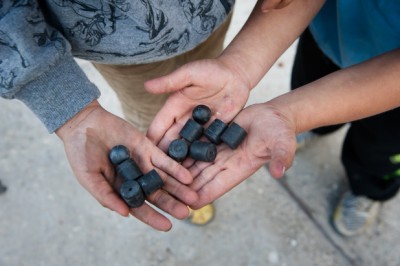Israeli Soldiers Shoot Children in the Head with Rubber-Coated Bullets
10-year-old palestinian child gets fractured skull, loses one eye

Palestinian children gather rubber-coated steel bullets after they have been fired by Israeli soldiers. (Ryan Rodrick Beiler / ActiveStills)
A Palestinian child from occupied East Jerusalem has lost an eye after being shot in the head with a rubber-coated steel bullet fired by an Israeli soldier.
Yahiya al-Amudi, 10, was struck by the bullet as he walked near an Israeli military checkpoint in Shuafat refugee camp on Thursday last week. The boy was subsequently hospitalized “with a fractured skull, jaw and left ear and had surgery to remove his left eye,” Ma’an News Agency reports. Al-Amudi was described as being in a critical condition.
Rubber-coated steel bullets are among Israel’s so-called arsenal of “non-lethal weapons.” The Israeli human rights group B’Tselem has referred to them, however, as “less fatal” weapons.
Although Israel promotes rubber-coated and sponge-tipped bullets, tear gas and stun grenades as “non-lethal,” they “are dangerous weapons that can cause death, severe injury or damage to property if improperly used,” a B’Tselem report notes.
Between 2005 and January 2013, at least ten Palestinians were killed by “less fatal” weapons, according to the group’s statistics.
Much like al-Amudi, Suliman al-Tardi, 20, also lost his eye after Israeli forces shot him in the face with a sponge-tipped bullet last month in the Issawiyeh neighborhood of East Jerusalem.
Children and adolescents are at particular risk of severe injury from weapons like rubber-coated steel and sponge-tipped bullets.
Children targeted
Last August, Muhammad Sunqrut, 16, was fatally shot in the head with a sponge-tipped bullet. Though police claimed he was shot in the leg while throwing stones, a subsequent autopsy showed that the bullet struck him in the head and his uncle dismissed the assertion that he was protesting.
Between January 2011 and December 2013, more than 1,500 of the estimated 8,500 Palestinians injured by weapons other than live ammunition were children, according to a report published by Amnesty International in March 2014.
In December last, a five-year-old boy, Muhammed Obeid, was shot in the face with a sponge-tipped bullet fired by an Israeli police officer as police forces clashed with local residents in the Issawiyeh neighborhood.
Ayed Abu Eqtaish, accountability director with Defense for Children International – Palestine (DCI-Palestine), explained that Israeli forces regularly misuse “non-lethal weapons.”
“From our documentation, we have discovered that Israel doesn’t abide by its own military regulations for the use of firearms and weapons like rubber-coated bullets,” he told The Electronic Intifada by telephone. “According to Israel’s rules, these weapons should not be used against women and children, but the evidence suggests that they are regularly used against them.”
Live ammunition
Israeli forces’ use of live ammunition against Palestinians, among them children, also continues unabated. At least 35 children have been injured by live ammunition since the beginning of this year, Abu Eqtaish said.
“The most important issue is that Israeli authorities do not open legitimate investigations into these violations, so Israel shows soldiers that they are immune from any responsibility,” he added.
A September 2014 report published by the Israeli human rights group Yesh Din found that only 1.4 percent of complaints submitted to Israeli military authorities between 2010 and 2013 resulted in an indictment.
At least eleven children were killed by live ammunition in the occupied West Bank throughout 2014, according to DCI-Palestine’s statistics.
Ali Abu Ghannam, 17, became the first Palestinian child or teenager killed by Israel in 2015 as he made his way home from a wedding party last month. Israeli Border Police shot him at the al-Zaim checkpoint near the al-Tur neighborhood of East Jerusalem.
The Israeli authorities claimed he attacked them with a knife, but his family rejects the assertion and insists he was killed “in cold blood,” as The Electronic Intifada reported at the time.
Electronic Intifada Editor’s note: an earlier version of this story erroneously referred to “steel-coated bullets” in two places where it was meant to state “rubber-coated steel bullets” and “sponge-tipped bullets.” The story has since been corrected.

